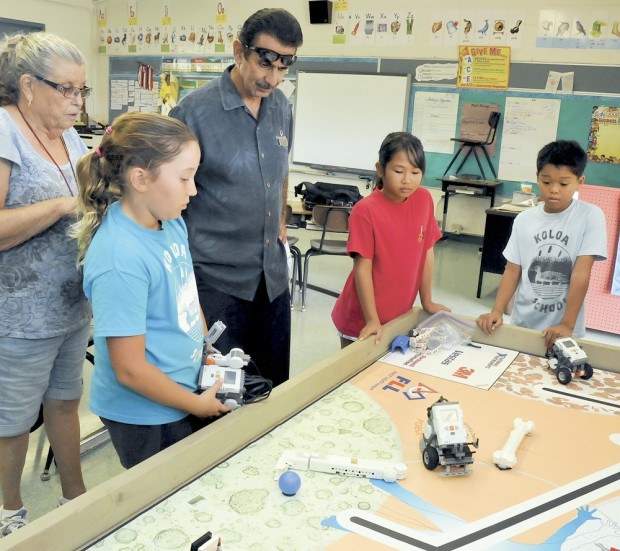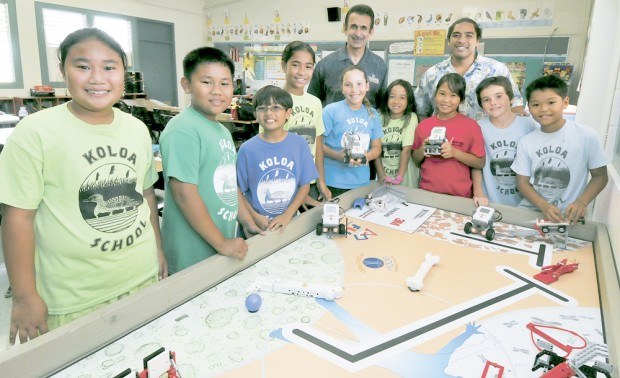KOLOA — Nine Koloa School Technos have real life inspiration for the FIRST LEGO League Body Forward Challenge at this Saturday’s Robotic Expo.
Keoni Pau — described by team parent Marianne Thesken as “El Capitan” and “General” of the nine-student team — had to have knee replacement. After the students learned of this, the Body Forward Challenge took on a new meaning.
The Challenge gives teams the opportunity to explore the cutting-edge world of biomedical engineering, to discover innovative ways to repair injuries, overcome genetic predispositions, and maximize the body’s potential, with the intended purpose of leading happier and healthier lives.
Following the discovery of Pau’s knee replacement, the nine students felt a connection leading them toward researching innovative solutions, including the use of nanotechnology.
More than 1 million people a year are affected by knee replacements and 10 million people suffer from osteoporosis, with 80 percent of that number being women, the team discovered through research. There are millions more who have low bone mass, or osteopenia, placing them at risk for osteoporosis and broken bones.
Dodger Middlebrook, one of the nine Technos, spearheaded the research effort that yielded a discussion with Robert Haddon, distinguished professor of chemical and environmental engineering and the director of the Center for Nanoscale Science and Engineering at the University of California, Riverside.
Haddon and his research team have discovered that nanotubes can be used to heal bones, the process making the body think that the treated nanotubes are part of the body and helping create bone growth, or actually regrowing the bone.
“The strength, flexibility, and light weight of carbon nanotubes, structures 100,000 times smaller than a human hair, allow them to act as scaffolds to hold up regenerating bone,” Haddon said in a paper entitled “A Bone Mimic Based on the Self-Assembly of Hydroxyapatite on Chemically Functionalized Single-Walled Carbon Nanotubes.”
Haddon said nanotubes are the perfect replacement — small, strong and carbon-based.
That discussion yielded a wealth of information to the students. Hokulani Iseri noted how hydroxyapitite and nanotube work to regrow bones. Benymar Tapucol and Trevor Carbonel, fellow students in the Koloa Technos, said they were surprised Haddon was not very interested in school until he got to college.
“It’s the magic of science and bioengineering,” said Leanna Thesken, another Koloa Techno.
The project was made possible by the 21st Century School Room Grant which encourages Community Learning Centers through the involvement of residents in the education of students.
Dennis Bonilla, a Koloa Technos adviser, said the idea of the Body Forward Challenge is to program Lego robots to perform a number of tasks set out on a competition board.
“Of course, there’s not enough time to do all of the tasks,” Bonilla said. “But the students need to be able to figure out the points for each task done, and be able to amass the greatest number of points with what they have available, including time.”
The FLL introduces children to a real-world challenge to be solved by research, critical thinking and imagination, states a Koloa School release. Student teams work with an adult mentor to design, build, and program a Lego-based robot to complete specific tasks on a thematic playing surface, scoring points for each completed task. The teams also research their topic and develop a solution to be presented to a team of judges.
All of this takes place Saturday at the Elsie Wilcox Elementary School cafeteria during the Robotic Expo, said Mia Ako of the Kaua‘i Economic Development Board.
Judging takes place in the morning with the robotics tournament to start with the opening ceremony at noon.
“The tournament will feature 12 robotics teams representing eight elementary schools and two middle schools from around Kaua‘i,” Ako said. “A total of more than 200 students will be involved with the event and promises to be a fast-paced, lively activity, full of excitement and cheering.”
The Koloa School Technos are no stranger to the FLL competition, having advanced to the state competition for the past two years.
“Last year, we were one of three schools that made it to states,” Pau said. “In 2008, we did okay, but we advanced because we hosted the event.”
Of the team, Pau said three of the nine students — Sheila Cadiente, DanikaViluan and Kysen Dikilato — are returnees. The remaining six, Trevor Carbonel, Cheyenne Duarte, Hokulani Iseri, Dodger Middlebrook, Benymar Tapucol and Leanna Thesken, are students experiencing the FLL for the first time.
“It’s a great program,” said Pau, who has been coaching the students since its inception. “It is great for problem-solving. It helps the kids to think outside the box, and I keep trying to impress on them that we can have locally grown engineers, mechanics, and other careers in the science field. They can do these things.”



